Romanian village set to become Nato's biggest airbase in Europe
BBC carries an article about Romanian village which is set to become Nato's biggest airbase in Europe, Caliber.Az reprints the article.
Six RAF Eurofighter Typhoons sit on the taxiway, engines roaring on two, as the ground staff hurry about, adding the finishing touches before take-off.
In the distance, a cloud of dust rises in the summer haze over the construction site of the second runway, 3.5km (2 miles) long, beside the first. The hot northerly wind buffets the new hangars and the old.
Mihai Kogalniceanu (MK) airbase takes its name from the village nearby, itself named after a 19th Century liberal politician.
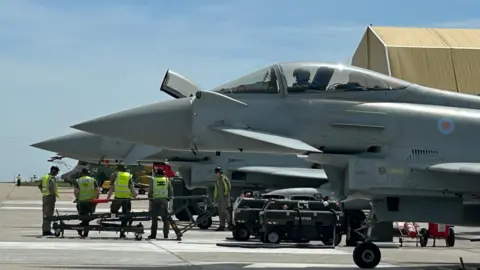
Now, it is the unlikely setting for what is turning into the biggest Nato base in Europe, bigger even than Ramstein in Germany.
Russian President Vladimir Putin justified his war in Ukraine on the grounds that Nato is encroaching on Russia’s European flank. In response to his invasion, more pieces have moved forward on the Nato chessboard.
The MK base will soon have a squadron of Romanian F-16s - recently bought from Norway - as well as MQ-9 Reaper drones, and a military city through which Nato army, air force and naval personnel from 32 countries will rotate.
The latest arrivals are the Finns. Just 20km (12 miles) from the Black Sea coast, the base is 300km from Odesa, as the fighter flies, and 400km from Sevastopol in Russian-occupied Crimea.
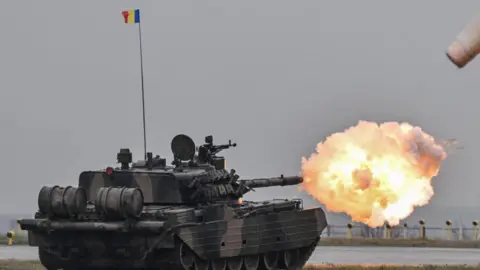
This is RAF pilot Flt Lt Charlie Tagg’s third and final tour of duty here.
“There's a much bigger US presence here, a lot more infrastructure, accommodation, people and equipment.”
Russia’s invasion of Ukraine has changed both the areas he flies over, he says, and the strategic posture of the mission. In 2021, on his last tour, Nato fighter pilots flew far out over international waters in the Black Sea. But now they stick to the 12 nautical mile zone above Romanian and Bulgarian territorial waters, “to avoid misunderstandings, escalatory situations with the Russians”.
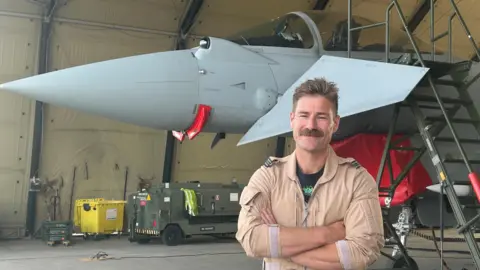
“Previously we were here as a deterrence to any Russian aggression. Now it’s more as a reassurance to other Nato countries, such as Romania, that we are here, and we're willing to defend.”
There has been no call to intercept a Russian plane since he arrived, he says, though there were on previous missions, over the Baltic.
“They will just be blundering through - it's not against any international law, they are entitled to do that. But we’ll put an aircraft next to that adversary aircraft. From a posturing point of view, it shows the Russians… that we are active. We're flying with armed jets, so it sends a clear message.
"And it also provides valuable intelligence for us, we're recording serial numbers of aircraft, and the weapons that those aircraft are carrying, so it feeds into the whole intelligence picture as well.”
Late at night at the British compound on the MK base he watches the war unfold in neighbouring Ukraine on his radar screens.
“We could see Shahed drones going into Odesa. The heat sources on the ground, where the weapons are impacting, to radar feeds that are tracking aircraft, both friendly aircraft and not so friendly aircraft as well. So it is quite surreal.”
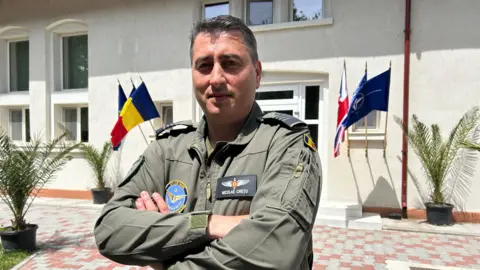
While Nato jets avoid unnecessary encounters with the Russians, there have been two known incidents over the Black Sea. In September 2022 a Russian pilot misunderstood a command from ground control, and narrowly failed to shoot down a British intelligence-gathering plane with a crew of up to 30.
In March 2023, a US MQ-9 Reaper drone, flown from Romania, was deliberately brought down by a Russian SU-27 “Flanker” jet, over international waters.
Everyday life at MK base, for all this, is mostly calm. In front of base commander Nicolae Cretu’s office block, the seagulls and crows are noisily harvesting a row of cherry trees. In his semi-permanent office, Scott Delay of American Army Support - Black Sea, plans logistics for the 1,840 US personnel the base currently supports.
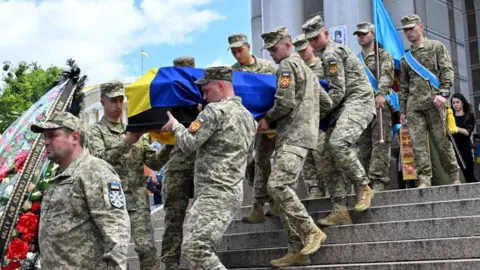
“We try to provide a home-like feel for them while they're here. So it's really no different than any community. It just has a fence around it.”
One thing US soldiers have trouble getting used to, he says, is that delivery times for items ordered on the internet can be weeks in Romania, rather than hours.
Before I leave the base, British pilot Charlie Tagg shows me round his plane. Up close, the Typhoon looks potent but a little aged. But the weapons, he explains, are upgraded all the time. It can now drop three different kinds of bombs.
“And we're getting new radars in, which will allow us to detect and engage threats even further away.”








